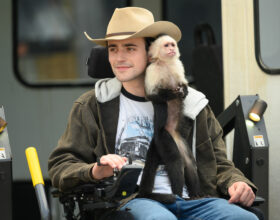This is a fascinating episode of Curiosity Quest, hosted by Joel Greene. In every episode the host addresses questions that viewers have. In this case, a viewer wants to know how milk is turned into cheese. The show is fast-paced, packing a lot of visuals and information into its 25-minute time frame. It also features fun facts.
The show opens with visuals of Joel looking into a book, using a magnifying glass and bursts of color. It’s a catchy opening featuring peppy music. Joel visits Waterloo, Wisconsin, a dairy farm, Crave Brothers Farms, LLC. Charlie, Tom, George and Mark are brothers who run the business.
George is in charge of the cheese factory, which is called Crave Brothers Farmstead Cheese, LLC. It’s right across the street from the dairy farm. A fun fact: Wisconsin cows produce enough milk to fill ten gallons for each person living in Wisconsin. Some cows produce 150 to 280 pounds of milk. This place milks one thousand cows three times per day.
Host Joel Greene gets drafted and involved and winds up milking cows and making the cheese. The milk is pasteurized, heated up to 162 degrees for 16 seconds, and any bacteria is killed. A fun fact is that pasteurization is named after its creator, Louis Pasteur.
Wisconsin produces more cheese than any other state in the United States. And they produce more cheese than most companies in the world. For one pound of cheese, ten pounds of milk are required.
Visuals include the cheese producer washing hands in hot water, and pasteurizing the milk in the vat, and pouring in cultures, live organisms. Eventually it is changed from liquid to a solid state. This process is called coagulation.
They cut away the curds and whey. They sell whey to companies for baby formula, protein drinks and so forth. Nothing is wasted. All cheese is white but they add coloring to make the cheese yellow or orange. It’s then dumped into salt water to make it harder and firmer. It’s drained, placed in an aging cellar for two weeks, and in most cases it is shipped out after a month.
This wholesome episode has procured our Dove seal for All Ages.
The Dove Take
This episode is educational and the next time you pass by cheese in the grocery store you will know the process that goes into the finished product.





